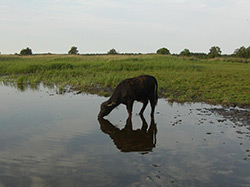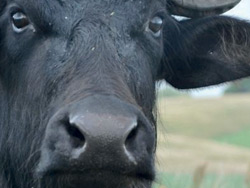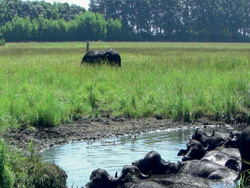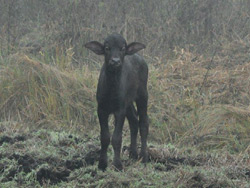Water buffalo (Bubalus arnee)
In brief
Water buffalo are primarily used for landscape maintenance. They have special hoof physiology which enables them to walk on sites that are wet all-year round. Water buffalo are characterized by high adaptability to different climatic and environmental conditions. They are considered lightweight, and cows reach a total of 600-800 kg, adult bulls 800-1,000 kg.
Other robust breeds suitable for low intensity fen management include Aberdeen Angus, Hecker, Fjäll, Galloway, Hinterwald, and Scottish Highland cattle. These breeds are characterized by low weight (approx. 400 -500 kg), their undemanding nature, and robustness.
Water level: 0-20 cm below surface in summer, above surface in winter (water level: 4+/5+)
Stocking rate: 0.6-1.6 head per hectare
Utilization: Landscape management, milk and meat production, cow-calf operation.
Emission reduction: Approx. 20 t CO2 eq. per hectare per year (compared to nutrient-rich, drained fens).
Potential
Grazing with water buffalo or other robust breeds makes it possible to preserve traditional farming methods and the cultural landscape. Selective grazing and trampling damage results in increased structural diversity of vegetation and soil, which can have positive effects on biodiversity. By browsing reeds and woody plants, water buffalo can maintain an open structure in wet sites. Numerous bird species use these pastures as breeding, resting, or feeding sites.
Sites

Wet sites (water level 0-20 cm below ground level) can be grazed by water buffalo provided that dry mineral soil areas are adjacent where the animals can retreat to. Protection from the cold, wet, wind and heat must be available. The animals are not demanding and can theoretically be kept outside all year round. Since they must be fed in winter, they are usually kept on drier land close to the farm during this period. Other robust breeds are also suitable for low intensity management of moist and wet lowland grassland (water level 20 -45 cm below ground level).
Herd management
The herd size of water buffalo depends on the site conditions (area size, soil structure) as well as the ability to provide supplementary feed in winter. Due to long inter-calving periods and difficultly detecting cows in heat, stud bulls are used. The recommended herd size is 20 - 30 animals and the recommended stocking rate is 0.6 - 1.2 livestock units (LSU) per ha for water buffalo or 0.8 - 1.4 LSU per ha for extensive cattle. This results in a pasture of approximately 30 ha. The wide range of stocking rates depends on the location and maintenance target. Water buffalo select feed according to energy value. Therefore, the poorer the plants, the greater the plant selection must be.
Supplementary feeding with concentrated feed should be avoided to prevent addition of nutrients into the field and to keep feed costs low
Pasture management

Management
Water buffalo, unlike extensive cattle breeds, can utilize lower-energy stock. Water buffalo at Gut Darß (farm in Mecklenburg-Vorpommern, Germany), for example, gained 840 g per day per calf during the grazing period.
With robust breeds, it is important to control grazing. The forage value of wet meadows declines rapidly during the year, and it is important to graze these areas at the ideal time. Fencing out areas with better forage values beginning in June can artificially decrease the forage supply and force grazing of the wetter areas (called partial grazing). Otherwise, these areas will be visited too late when the forage value is already poor. As a result of selection by the animals, undesirable species (e.g., rushes, docks) can spread, which may need to be contained by mowing. In addition, attention must be paid to the spread of poisonous plants (marsh horsetail, water hemlock, and bittersweet).
Animal Health
Water buffalo are more robust to disease than conventional cattle breeds. Wet sites can be the source of hoof diseases and therefore cattle should be regularly examined and cared for. To ensure adequate mineral supply to the animals on organic sites, salt licks with mineral supplements should be provided.
Utilization

Water buffalo can be used for both milk and meat production. The meat of water buffalo is high quality, tastes like game meat, and is low in cholesterol and fat.
Low intensity grazing occurs mainly through calf-cow operations with the breeding of one calf per year per cow. Light heifers are also suitable for wetter areas.
Profitability
Profitability is determined by the possibilities for direct marketing in the area, the market price, and fertility management.
With water buffalo husbandry in a full pasture system, a profit margin of between 537 and 986 euros per cow can be achieved, depending on the price and the inter-calving period. Year-round free-range management is 25-30% cheaper then winter indoor management. Growth rates are strongly dependent on feed quality. Furthermore, the compensation through agri-environmental programs or maintenance contracts has a decisive influence on the profitability.
Implementation

Status of implementation & research projects
Grazing systems in wetlands are not so much economically motivated, but instead are mostly motivated by landscape care, and thus to a large extent are dependent on the compensation for these services. Water buffalo are already frequently used to manage landscapes in Germany, often in small herds in nature reserves with wet peatland sites. Larger herds exist, for example, in the Vorpommersche Boddenlandschaft National Park (Gut Darß GmbH und Co. KG) in Mecklenburg-Vorpommern, Germany. The meat is sold at a store on the farm.
Barriers
Fertility management and high-priced market are the main challenges in water buffalo farming. Due to the small number of slaughtered animals, it is difficult to develop a market, especially for the less valuable meat cuts. Furthermore, slaughtering requires additional considerations (thick skull plate, long hanging time).
Sources & further information
- Schröder, C., Schulze, P., Luthard, V. & Zeitz, J. 2015: DSS-TORBOS Steckbriefe
für Niedermoorbewirtschaftung bei unterschiedlichen Wasserverhältnissen: www.dss-torbos.de - Wichtmann, W., Schröder, C. & Joosten, H. (Hrsg.) 2016: Paludikultur – Bewirtschaftung nasser Moore.
Schweizerbart, Stuttgart, 272 Seiten - Tierärztliche Vereinigung für Tierschutz e.V. (2005) Artgemäße Haltung von Wasserbüffeln.
Merkblatt Nr. 102 - Flyer "Steckbrief Wasserbüffel"











